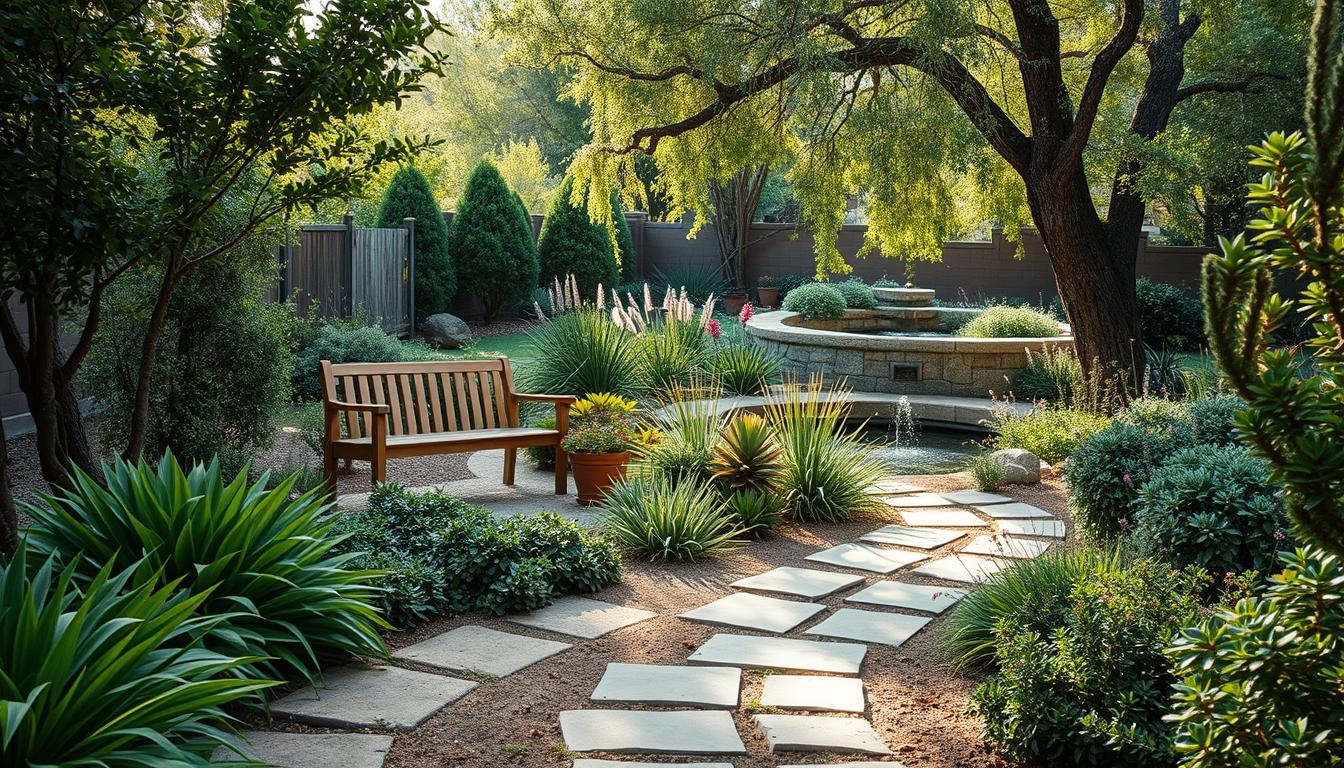Do you dream of a beautiful backyard without spending all weekend on it? You’re not alone. Today’s homeowners want outdoor spaces that are stunning but don’t require endless hours of work. The good news is that smart design choices can greatly reduce your garden work.
The key to simple outdoor living is in careful planning. By choosing the right plants, materials, and layouts, you can create spaces that mostly take care of themselves. This fits well with our busy lives today.
Low-maintenance garden layouts don’t have to be boring or empty. Today’s designs offer rich textures and interest all year round. They also let you add personal touches that show off your style. This means you can enjoy your outdoor space more, not just work on it.
In this guide, we’ll look at practical ways to create outdoor spaces that work with nature. You’ll learn about clever hardscaping and drought-tolerant plants. Discover how to build a garden that gives you more than it takes.
The Beauty of Simplicity in Garden Design
Creating a beautiful garden with little upkeep starts with simplicity. By removing unnecessary details, we reveal something truly striking. A simple garden is both beautiful and practical, offering a peaceful escape.
Simple gardens don’t mean they’re dull or empty. They’re about making smart choices that save time and effort. This way, gardens feel both timeless and modern, offering a calm break from our busy lives.
Why Low-Maintenance Doesn’t Mean Low-Appeal
Many think low-maintenance gardens are dull. But, the truth is, some of the most stunning gardens are simple. They use strong shapes, key features, and plants to create lasting beauty.
These gardens highlight the beauty of natural materials and plants. A single tree or a few plants can be more striking than many. It’s about choosing a few high-quality elements that look good all year, with little care.
The Growing Trend Toward Simplified Outdoor Spaces
More people are choosing simple garden designs. This reflects a broader love for minimalism and caring for the planet. Simple gardens need less water, fewer chemicals, and less work.
Studies show homeowners spend about 70 hours a year on garden care. Simple designs can cut this time in half. This means more time to enjoy your garden, not just work on it.
Time-Saving Benefits for Modern Lifestyles
For those with busy lives, time is everything. Simple garden designs save time, making outdoor spaces more enjoyable. They offer a way to connect with nature without the stress of constant upkeep.
The beauty of simple garden design is in its harmony. It meets our need for natural beauty while respecting our time and the planet. This way, we create spaces that are good for our souls and our schedules.
Understanding Low-Maintenance Garden Layouts
Creating a garden that looks great with little effort is all about smart design. These layouts let you enjoy your outdoor space without endless gardening tasks. They balance beauty now and care later.
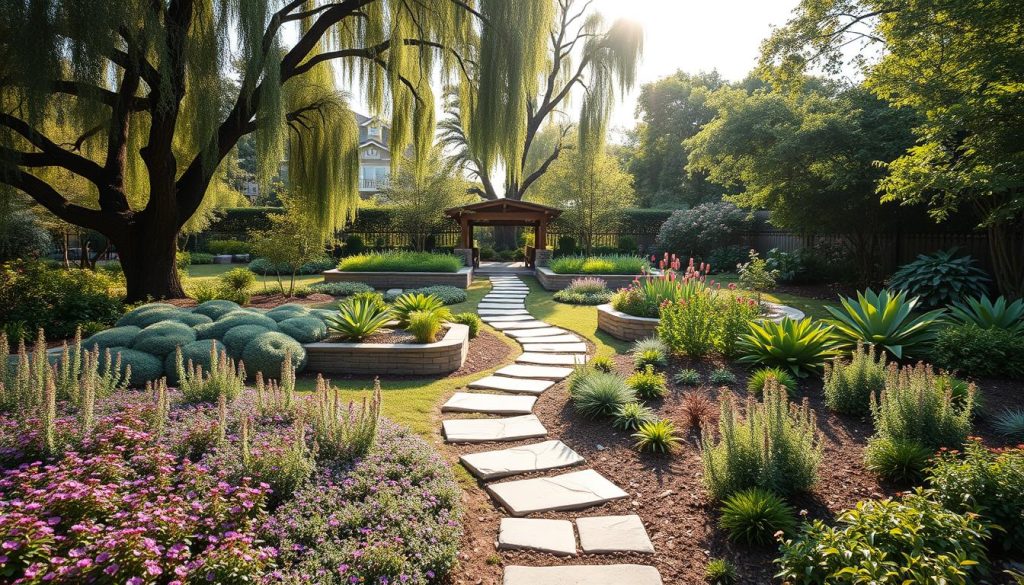
Key Principles of Easy-Care Design
Good low-maintenance gardens follow key rules to save time and keep looking good. First, group plants by their needs like water and sun. This makes caring for them easier and prevents mistakes.
Clear garden beds with sharp edges help plants stay in place. This makes mowing and trimming easier. Wide paths between beds let you move around easily and care for your garden.
Picking the right plants is also key. Choose ones that do well in your area with little help. Local plants often need less water and care than exotic ones.
Balancing Aesthetics with Practicality
The best gardens mix beauty with usefulness. While pretty plants are important, think about their needs too. This ensures your garden stays beautiful over time.
Add things like rocks or sculptures that look good all year. These features keep your garden interesting without needing constant upkeep. They help your garden look good through all seasons.
Use the same plants or design elements to create a sense of unity. This makes caring for your garden easier since you’re dealing with fewer types of plants.
Planning for Reduced Long-Term Maintenance
Good planning from the start saves a lot of work later. Plan for how big plants will get to avoid too much pruning. Plant them far enough apart, even if it looks empty at first.
Use smart watering systems like drip lines to save water and fight weeds. Automatic timers make watering even easier.
Choose mulch that lasts, like river rock, to keep weeds away. It also adds texture to your garden.
| Design Approach | Maintenance Level | Visual Impact | Initial Investment |
|---|---|---|---|
| Defined Garden Rooms | Low | High | Medium |
| Mixed Border Plantings | Medium | High | Medium |
| Hardscape Dominant | Very Low | Medium | High |
| Native Plant Meadow | Low-Medium | High (Seasonal) | Low |
| Container Garden Focus | Medium | High | Low |
Assessing Your Outdoor Space and Climate
Creating a garden that needs little care starts with knowing your outdoor space and climate. This first step helps avoid the mistake of fighting nature. By matching your garden design with your space, you cut down on upkeep.
Evaluating Sunlight, Soil, and Water Conditions
Start by mapping your yard’s sunlight patterns. Note which areas get full sun, partial sun, or shade. These patterns change with the seasons, so observe at different times.
Then, check your soil quality. Take samples and test for pH and nutrients. Many county offices offer cheap soil tests. Also, watch how water drains by digging a hole and filling it with water.
Water and drainage are key. Find where water collects after rain and where it dries fast. These spots help pick drought-tolerant plants that need little water.
Working with Your Local Climate Zone
Your climate zone affects which plants grow well. Gardening with your climate is key to low-maintenance gardening.
Understanding USDA Hardiness Zones
The USDA Hardiness Zone map divides North America into 13 zones by winter temperatures. Knowing your zone helps pick plants that survive your winters.
For example, Zone 7 plants rated for Zones 5-7 will do well. But Zone 8-10 plants might not make it through cold snaps. Drought-tolerant plants fit specific zones, so choose wisely.
Microclimates in Your Yard
Yards have microclimates, areas with different conditions. South walls get warmer, perfect for some plants. Low spots collect cold air, creating frost pockets.
Other factors include wind, building or tree shadows, and reflective surfaces. Knowing these helps place plants where they’ll do best with little care.
For example, plants like lavender and sage do well in hot spots. Shade-loving plants prefer cooler areas. This placement cuts down on watering and upkeep.
Smart Hardscaping Solutions
Smart hardscaping can turn your yard into a peaceful spot that takes care of itself. It uses structural elements to make a garden that looks good with little effort. This also helps save water.
Hardscaping cuts down on plant care and makes spaces for fun and relaxation. The right mix of hard surfaces and plants adds beauty and reduces upkeep like watering and mowing.
Patios, Walkways, and Borders
Patios and walkways are useful and save time. Materials like flagstone and stamped concrete are tough and stop weeds.
Here are some easy-to-maintain pathway options:
- Concrete pavers with polymeric sand joints that inhibit weeds
- Natural stone set in crushed stone or decomposed granite
- Brick pathways with permanent edging to prevent spreading
- Poured concrete with decorative scoring or staining
Strong borders keep grass out and make your yard look neat. Metal, stone, or concrete edging needs no upkeep once set up.
Decorative Gravel and Stone Features
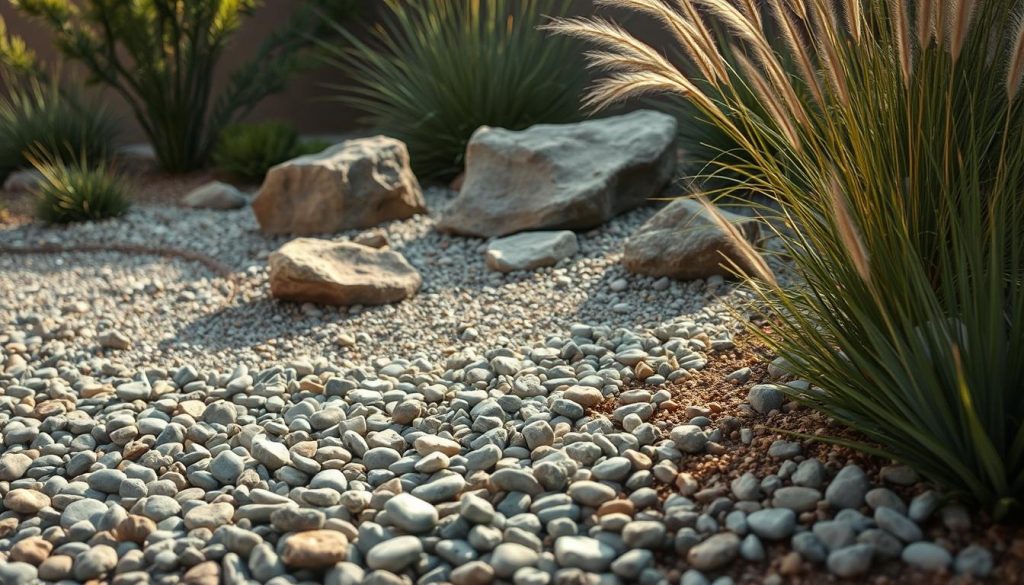
Gravel and stone add beauty and practical benefits to your yard. Decorative gravel comes in many colors and sizes, making areas that need no water or mowing.
Dry creek beds are beautiful and manage water runoff. Use larger stones and drought-tolerant plants for a natural look.
Stone features like boulders and rock gardens are year-round beauties. They also help insects and create special plant spots.
Low-Maintenance Decking Options
Decks add space but traditional wood needs a lot of care. Today, there are wood-like options that need much less work.
Composite Materials vs. Traditional Wood
Composite decking is made from wood and plastic, lasting longer without rot or bugs. It costs a bit more but saves on upkeep.
Wood decking is cheaper but needs constant care. Cedar and redwood resist decay but still need treatment. Pressure-treated pine is cheaper but needs to be replaced often.
For even less work, try aluminum or PVC decking. They never rot or warp but don’t look like wood or composites. Your choice depends on your budget, style, and maintenance time.
Drought-Tolerant Landscaping Strategies
Drought-tolerant landscaping is a smart way to design gardens. It saves water and looks great. This method is perfect for those who want to save water and have a beautiful outdoor space.
Xeriscaping Fundamentals
Xeriscaping is a way to garden that uses little to no extra water. It’s not just for hot, dry places. It works well in any climate.
The seven core principles of xeriscaping help make gardens water-efficient:
- Thoughtful planning and design
- Soil improvement for better water retention
- Efficient irrigation systems
- Strategic use of mulch
- Limited turf areas
- Drought-tolerant plant selection
- Proper maintenance routines
Using these principles can cut water use by 50-75%. You’ll also have a garden that’s easy to care for.
Water-Wise Plant Selection
Picking the right plants is key for a low-maintenance garden. Native and adapted plants need less care once they’re settled.
In the Northeast, try black-eyed Susans, butterfly weed, and purple coneflower. Southern gardens do well with lantana, yarrow, and Texas sage. Midwest gardeners should use prairie dropseed, blazing star, and purple prairie clover. Western landscapes benefit from manzanita, California poppy, and blue grama grass.
Look for plants with features like silvery or hairy leaves, succulent tissues, or deep roots. These show they can handle drought. Choose plants that add interest with different textures, shapes, and colors, not just constant blooms.
Efficient Irrigation Systems
Drip Irrigation and Smart Controllers
Drip irrigation sends water straight to the roots, cutting down on evaporation and runoff. It can save 30-50% of water compared to sprinklers. Drip systems are cheaper than traditional irrigation and can grow with your garden.
Smart irrigation controllers make watering even more efficient. They adjust schedules based on weather and soil moisture. These systems use local weather data or sensors to water just when needed, avoiding waste.
Rainwater Harvesting Techniques
Capturing rainwater is a great way to irrigate your garden. Simple rain barrels can collect hundreds of gallons. For more, underground cisterns can hold thousands of gallons for dry times.
Even small setups can reduce your need for city water. A 1,000 square foot roof can collect about 600 gallons from just one inch of rain. That’s enough to water a medium-sized garden for weeks.
By choosing the right plants and using efficient irrigation and rainwater harvesting, you’ll have a garden that’s good for the environment. It also saves you time and money.
Rock Gardens and Succulent Landscapes
Rock gardens and succulent landscapes are great for those who want a beautiful garden with little work. They use stone and plants that look good all year with almost no care. This mix of stone and drought-resistant plants gets better with time.
Designing with Texture and Form
Rock gardens are special because of their mix of textures and shapes. They don’t need flowers to look good, unlike other gardens. Instead, they use different elements to catch the eye.
When making your rock garden, think about these contrasts:
- Smooth river stones against jagged rock formations
- Spiky succulents next to rounded pebbles
- Fine-leaved plants alongside bold, architectural specimens
- Vertical stone elements complementing horizontal ground covers
These gardens stay interesting all year. Even in winter, they look good thanks to stones and evergreen succulents.
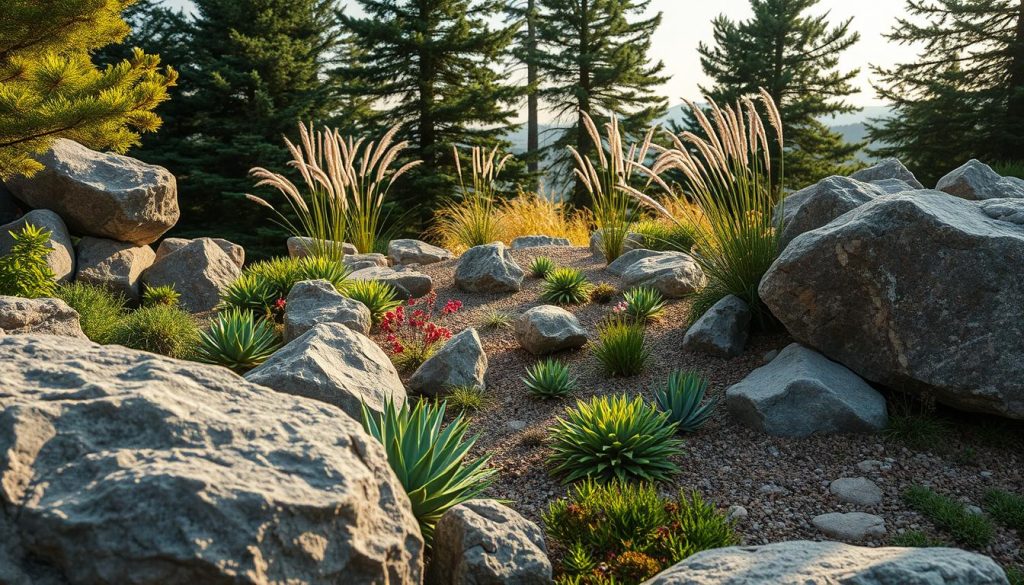
Low-Water Succulent Varieties for Different Climates
Succulent gardens can thrive in many places, not just hot, dry areas. The secret is picking the right plants for your climate.
In cold areas (USDA zones 4-6), choose hardy plants like Sempervivum, Sedum, and some Opuntia. These plants can handle freezing and still look great.
In milder climates (zones 7-9), you can grow Echeveria, Aeonium, and many Aloe varieties. These plants have beautiful shapes and colors and need little water.
In warm places (zones 10-11), you can have a wide range of succulents. Plants like Agave, Euphorbia, and exotic cacti add drama to your garden.
Creating Visual Interest with Rock Arrangements
Placing rocks in your garden should look natural but also serve a purpose. Big rocks can anchor the garden and provide a backdrop for plants. Medium rocks can create terraces and define areas for plants.
To make rocks look natural, bury big stones and group them in odd numbers. This makes your garden look more real than just placing rocks on the ground.
Rock placement also helps with erosion, keeps plants warm, and saves water. It’s not just about looks.
Alpine Garden Inspiration
Alpine gardens, with their rocks and hardy plants, are great for easy-care gardens. They show how to make a beautiful garden in tough conditions with little soil and changing weather.
You don’t need mountains to use alpine design. Create small “mountains” with rocks, use crevices for plants, and pick plants that don’t spread too much.
Alpine gardens turn hard places into beautiful spots. That narrow strip by your driveway or a hard-to-mow slope can become a stunning feature with the right plants and rocks.
Native Plant Gardens: Beauty with Minimal Effort
Using native plants turns ordinary gardens into beautiful, easy-to-care-for spaces. These gardens are good for the environment and look great. They need little upkeep, making them perfect for busy people.
Benefits of Choosing Regional Species
Native plants are made for your local climate and soil. They need less water once they grow, saving time and water.
They also fight off local pests and diseases better than non-native plants. This means fewer bugs and no need for harmful chemicals.
Native plants don’t need as much fertilizer. Their roots get nutrients from the soil, cutting down on feeding needs.
Creating Habitat-Friendly Spaces
Native plants do more than just look good. They help rebuild local ecosystems. They feed and shelter birds, insects, and small animals.
A native garden is full of different spots for wildlife. Shrubs offer homes for birds, while open areas help insects hunt pests.
This setup works on its own, needing less help from us. It attracts beneficial insects and birds, controlling pests and adding life to your garden.
Low-Maintenance Native Plant Combinations
Good native gardens use plants that like the same things. In the Northeast, black-eyed Susans, purple coneflowers, and little bluestem grass work well together.
In the South, desert marigold, penstemons, and agave plants are perfect. They need little water and add color all year.
In the Pacific Northwest, sword ferns, salal, and flowering currant make beautiful, low-care gardens. They handle rain well and look good all year.
Pollinator-Friendly Options
Native plants are great for bees, butterflies, and hummingbirds. Milkweed is key for monarch butterflies, whose numbers are down.
Spring-blooming trees and shrubs like redbud and serviceberry feed early pollinators. They’re easy to care for and support pollinators.
Many native plants bloom for a long time or have seeds that feed pollinators. Goldenrod, asters, and sunflowers offer food in the fall and add color.
Native gardens don’t have to look wild. With the right design, they can be as beautiful as any garden. They’re easy to care for and good for the environment.
Permaculture Design for Self-Sustaining Gardens
Permaculture design is different from regular gardening. It aims to create ecosystems that take care of themselves. By arranging plants and landscape elements wisely, you can make a garden that needs less care but gives more food and beauty.
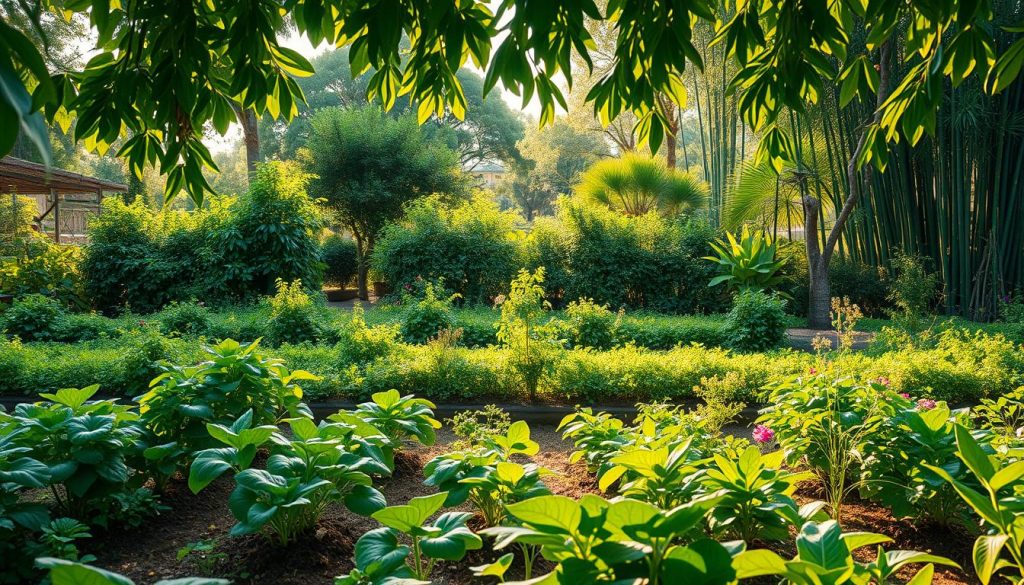
Permaculture is more than gardening; it’s a way to design sustainable landscapes. These gardens become self-sufficient over time, needing less human help. They need careful planning at first but offer long-term benefits like less watering and weeding.
Layering Plants for Maximum Efficiency
Vertical layering is a key part of permaculture design. It uses space well by mixing plants of different heights and root depths. This idea comes from forests where plants of all sizes work together.
A good permaculture garden has seven layers: tall trees, lower trees, shrubs, herbaceous plants, ground covers, root crops, and climbing plants. Each layer does something special, like providing food or attracting insects. For example, a fruit tree can shade herbs and bring up nutrients for other plants.
Companion Planting Strategies
Companion planting means growing plants together for their mutual benefit. In permaculture, these pairings help gardens fight pests and diseases without chemicals.
Some plants keep pests away, while others attract helpful insects. Certain plants even make each other taste better. For instance, basil near tomatoes improves their taste and keeps away tomato hornworms. Marigolds keep pests away and attract pollinators.
| Plant Combination | Benefits | Garden Location | Maintenance Level |
|---|---|---|---|
| Corn, Beans, Squash | Beans fix nitrogen, corn provides support, squash suppresses weeds | Full sun areas | Low |
| Tomatoes with Basil | Improved flavor, pest repellent | Sunny beds | Medium |
| Fruit trees with comfrey | Nutrient accumulation, mulch production | Orchard areas | Very low |
| Garlic with roses | Deters aphids and fungal diseases | Ornamental beds | Low |
Creating Ecological Balance
A good permaculture garden has ecological balance by welcoming biodiversity. This means having beneficial insects, birds, and even pests as part of a healthy ecosystem. When different species work together, they keep any one problem from getting out of hand.
Water features, even small ones, attract frogs, dragonflies, and birds. These animals help control insects. Healthy soil, made through composting and mulching, supports plants naturally.
By designing gardens that work with nature, permaculture creates spaces that thrive with little help. These sustainable gardens need less care but become more productive and beautiful over time.
Ground Cover Solutions and Mulching Techniques
Smart ground cover solutions and effective mulching techniques are key to an easy-care garden. Exposed soil quickly gets filled with weeds, and moisture evaporates fast. This makes gardening harder. By covering bare earth, you cut down on maintenance and boost plant health and soil quality.
The right ground coverage creates a self-sustaining system. It works for you, not against you, saving you time and effort.
Living Mulches and Spreading Plants
Living ground covers are a dynamic solution for bare soil. They create a beautiful, functional layer that naturally suppresses weeds. These spreading plants form dense mats that choke out unwanted vegetation.
For sunny spots, consider low-growing sedums, creeping thyme, or drought-tolerant ornamental grasses. They create carpets of interest with little water. Shaded areas benefit from sweet woodruff, pachysandra, or ajuga, which thrive in little sunlight and form lush green blankets.
When picking living ground covers, think about their growth habits. Some spread slowly and stay contained, while others move aggressively. Match their vigor to your needs—use more aggressive spreaders for problem areas and gentler options near prized perennials.
Organic vs. Inorganic Mulch Options
The mulch you choose affects both your garden’s look and maintenance. Organic mulches break down to enrich your soil, while inorganic options provide more permanent solutions.
| Mulch Type | Benefits | Drawbacks | Ideal Application |
|---|---|---|---|
| Wood Chips | Improves soil, natural look, affordable | Needs replacement every 1-2 years | Around trees and shrubs (3-4″ depth) |
| Compost | Adds nutrients, improves soil biology | Breaks down quickly, may contain seeds | Vegetable gardens (1-2″ depth) |
| Decorative Gravel | Permanent, excellent drainage, modern look | Doesn’t improve soil, can scatter | Pathways and drought-tolerant beds (2″ depth) |
| Pine Straw | Lightweight, acidic (good for acid-loving plants) | Can blow away in windy areas | Around azaleas, blueberries (3″ depth) |
For most gardens, organic mulches like wood chips or shredded bark are best. Apply them at a depth of 2-3 inches. Keep them pulled back from plant stems and tree trunks to prevent rot.
Inorganic options like crushed stone or river rock are good for permanent, no-maintenance areas. They won’t break down but also won’t improve soil health. They’re ideal for pathways or around foundation plantings.
Weed Prevention Strategies
Preventing weeds before they start saves a lot of time. A proactive approach combines several techniques for the best results. Start by removing existing weeds completely, including their roots, before applying any ground covering.
Mulch depth is key in weed prevention. Too thin, and weeds can get through; too thick, and roots may lack oxygen. The ideal depth is 2-3 inches for organic mulches, refreshed annually as they decompose.
Consider using cardboard or several layers of newspaper as an initial weed barrier before applying mulch. This biodegradable layer blocks light to weed seeds while eventually breaking down to improve soil structure.
Landscape Fabric Pros and Cons
Landscape fabric is a tempting weed prevention solution, but it needs careful consideration. It effectively blocks weeds while allowing water and some air to reach roots. It works well under inorganic mulches like gravel for a permanent solution.
But landscape fabric has significant drawbacks. Over time, soil and debris accumulate on top, creating a new growing medium for weeds. It also prevents beneficial organic matter from naturally incorporating into the soil, potentially reducing soil health over years.
Landscape fabric is best for specific situations: under pathways, beneath decks, or in areas with inorganic mulch and no planting scheme changes. For typical garden beds, organic mulching approaches generally provide better long-term results with fewer complications.
No weed prevention strategy is completely maintenance-free. Even the best systems require occasional attention to catch breakthrough weeds before they spread. The key difference is that with proper ground covering techniques, this maintenance becomes a quick, occasional task rather than a constant battle.
Implementing Your Low-Maintenance Outdoor Sanctuary
Ready to make your outdoor space better? Start by thinking about your time, budget, and love for gardening. Begin with one area at a time instead of the whole yard.
First, draw a map of your space. Note the sun patterns, plants you want to keep, and problem spots. This map will guide you as you add elements like drought-tolerant plants and native species.
Start with the basics like irrigation systems, pathways, and borders. This step sets up your garden and prevents damage to new plants. It also gives your garden structure right away.
Even easy gardens need some care at first. New plants need water until their roots grow strong. This initial effort saves you time and effort later.
If money or time is tight, do your garden in stages. Start with areas you see or use most. Completing one section will encourage you to keep going.
Low-maintenance gardens grow better with less work. As plants grow, they need less care, making your garden look better. Your garden should make you happy, not add to your chores.
Designing with ease in mind means you’ll have more time to enjoy your garden. Your garden should be a place of peace, not a burden.

